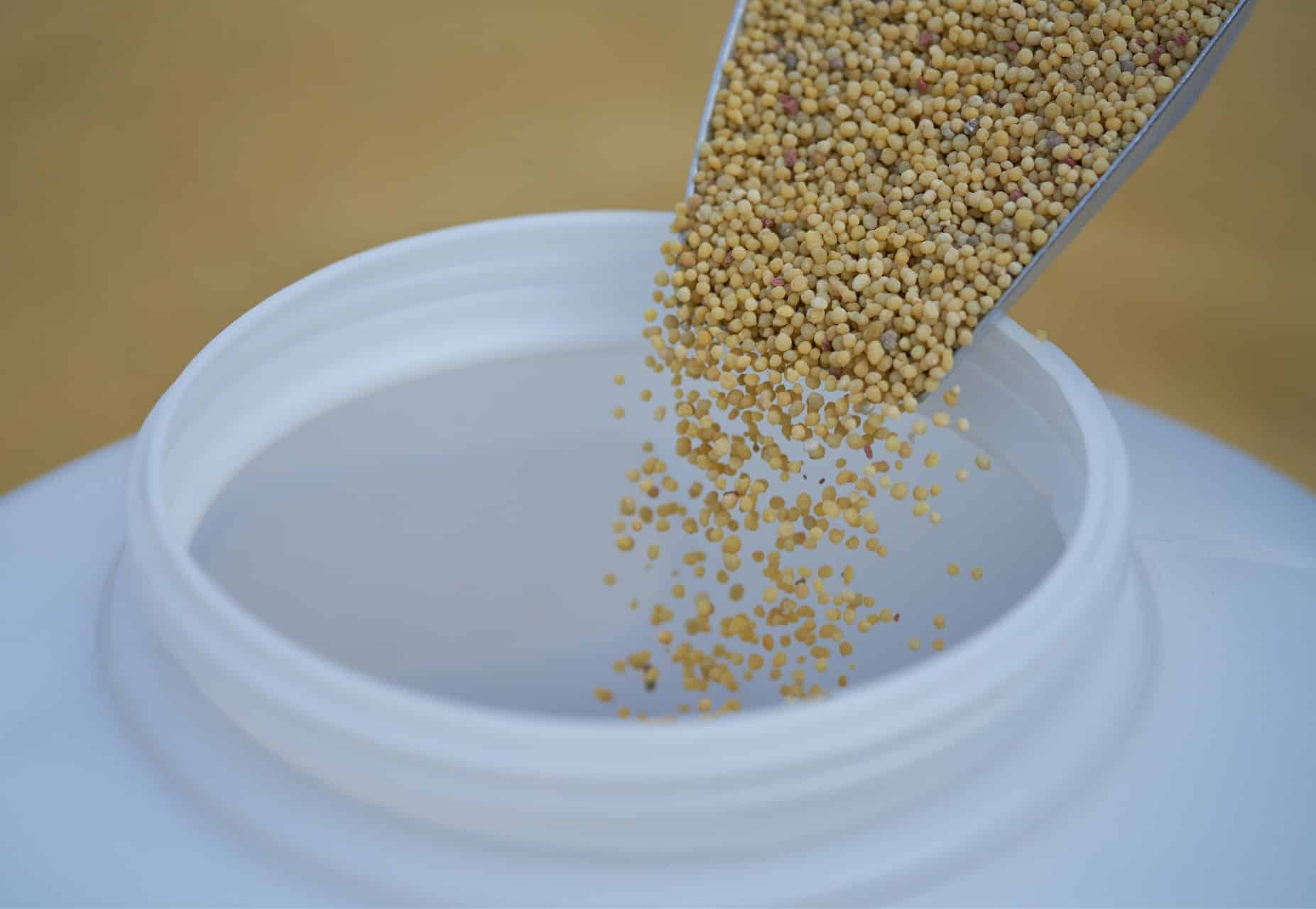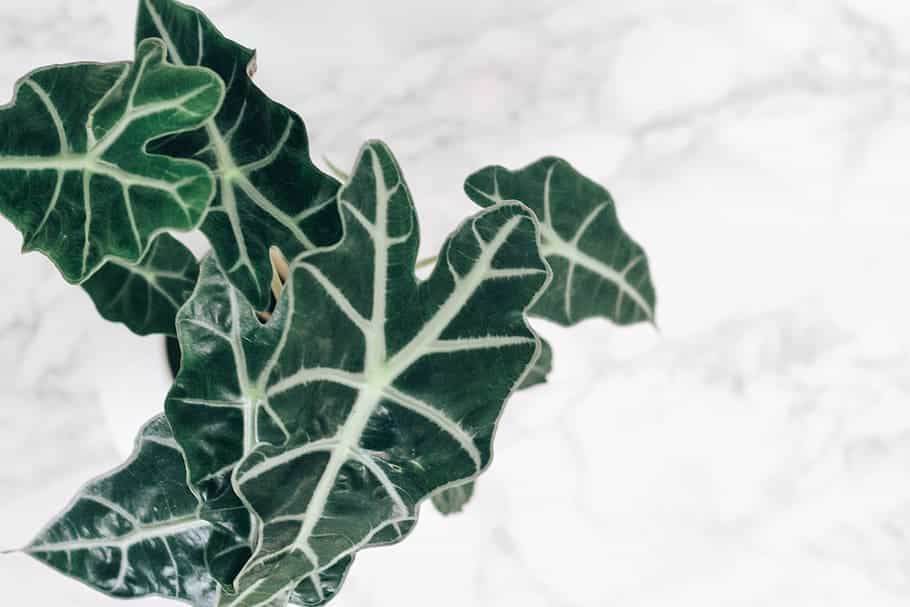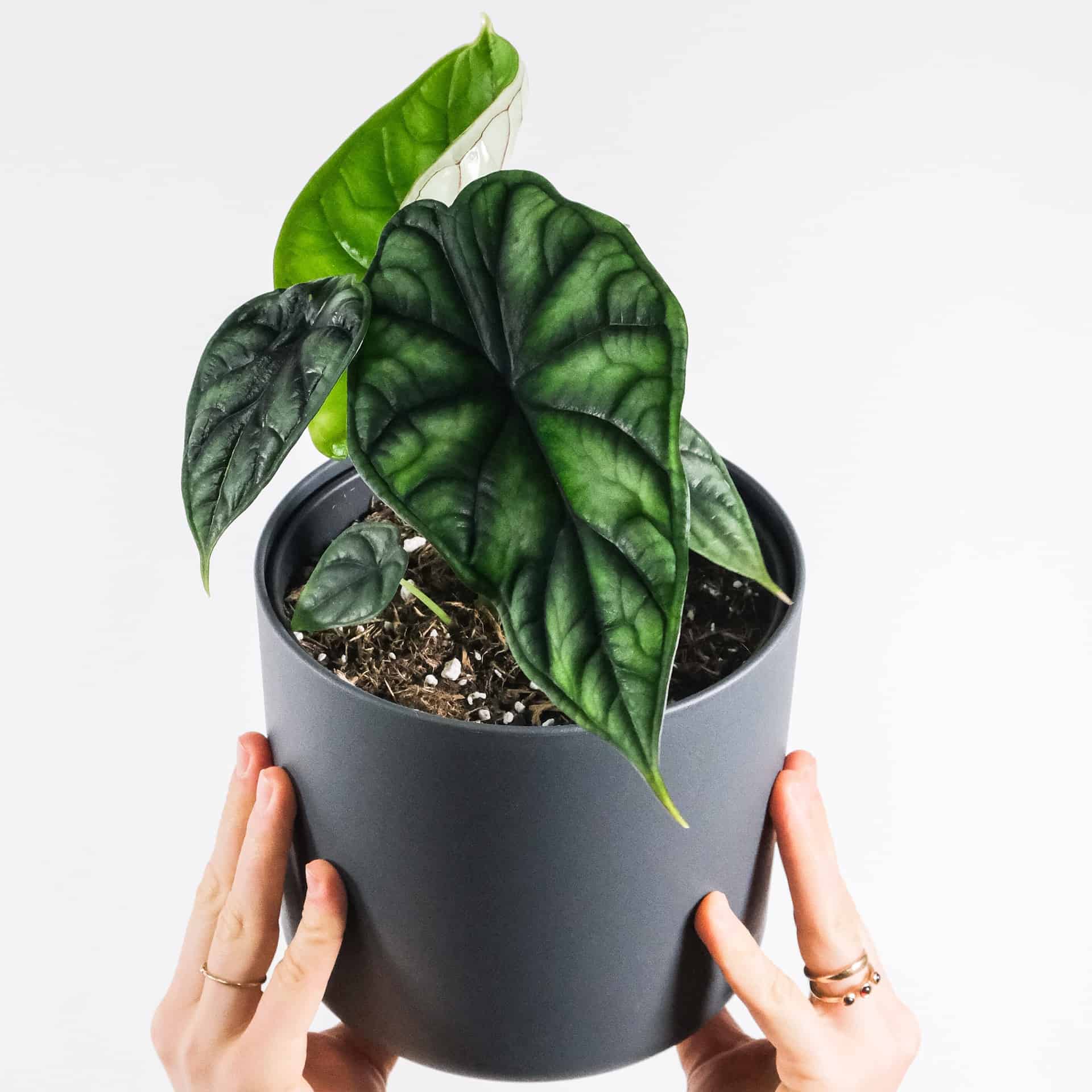No products in the cart.
No element in the home, even with a superior design, will make a bold statement like the Pink Dragon Alocasia. The lush potted plant looks fabulous with your other plants and will become the focal point in your living space.
Recently we looked at caring for the Alocasia calidora, which is also an attractive species. But add this beauty to your tropical environment. You have a jungle vibe.
More About Alocasia Pink Dragon Plant
The evergreen perennial cultivar is known as the Alocasia Pink Dragon making for a four feet tall focal point in any home. The houseplants belong to the Araceae family and have bright pink stems with oblong foliage that is light green on the top with a burgundy underside.
The deep veins resemble dragon scales; the best part for plant parents is that they need little care. Some other common names are the Rose Elephant Dragon or the Elephant Ear Pink Dragon.
The Alocasia Pink Dragon is native to Southeast Asia and subtropical regions and grows in tropical forests displaying those gorgeous glossy dark green leaves. One thing is sure when you add it to your plant collection; it will not disappoint with some tender loving care.
Caring For Pink Stem Alocasia Tropical Plants

The Pink Dragon thrives in some fast-draining soil that is aerated well and is rich in organic matter. In a brightly lit spot, it will help promote faster growth and only needs watering when the soils are a bit dry. So, to know more about caring for your Pink Dragon Alocasia, ensure that you read the following.
Best Soil For Pink Dragon Alocasia
Your Pink Dragon plant will thrive when grown in loamy soils with excellent drainage holes. We recommend potting soil consisting of equal parts of perlite, peat moss, and regular potting soil for your tropical plant.
The potting medium helps retain enough moisture but allows excess water to drain without causing water logging or damp conditions around the root system. When you can get the growing medium correct, you will be able to get a fully mature Pink Dragon.
When soil retains too much water, the tuberous roots can start developing root rot and decaying away. So, with a blend of perlite and peat moss, your ornamental plants grow healthy. Another compound you can also add in some poultry grit made up of minuscule particles and stone.
Suitable Light For Pink Dragon Alocasia

Your Alocasia Pink Dragon plant will be happy in a bright light, sunny room. With decent sunlight, it helps keep the variegated leaves looking great. Still, intense or direct sun can scorch the foliage.
Hence, a suitable spot for the Pink Dragon is at an east or west-facing window. You can place it at a south-facing window but will need bright indirect light using sheer curtains or placing it a few feet away from it.
Watering Pink Dragon
One peculiar thing that happens to your Pink Dragon Alocasia is guttation. The effect gives the impression that your plant is perspiring as tiny droplets appear on the leaf surface. However, it is a typical appearance, and there is no need to feel alarmed as it usually happens in a high-moisture plant.
For this reason, your plant needs consistently moist soil as it helps eliminate the transpiration of water when not active at night—the plant expels water through its stomata which are tiny holes in the foliage.
It does the process by pulling up the surplus water from the plant base. So when guttation happens, it does not show that your plants receive too much water, but if sweating appears, it only helps to maintain your plant’s equilibrium.
But if it happens with yellowing leaves or becomes mushy, you need to reduce the watering as it can result in root rot. So, do not go overboard with watering, and keep checking if the soil is dry the first top two inches.
Fertilizing Alocasia Pink Dragon Plants

While not mandatory, it helps to feed your Alocasia genus during the growing season. It helps to use a houseplant fertilizer applied in early spring through late summer. When fertilizing, it helps to make the feed half-strength applied every second week.
The fertilizer you use for your Alocasia species can be organic or chemical-based. Still, chemical fertilizers tend to create a salt buildup resulting in fertilizer burn. We recommend using organic feed as a safer alternative.
Alocasia Pink Dragon Temperature and Humidity
To consider the best temperature and humidity for your indoor plant or outdoor garden, consider the natural environments it grows. When it comes to the care for Alocasia Pink Dragon, it flourishes in warm temperatures.
Provide your plant with a natural habitat of 64°F to 86°F (18-30 degrees Celcius.) Another essential point is to keep your plant away from cold drafts or too-warm vents. When your plant shows dropped leaves, it can result from a change in the temperature.
Your plant needs humid environments to thrive, as important as providing well-draining soil with bright indirect sunlight. It will help aim for 60% to 70% humidity levels. Preferably do not let your plant stand close to air conditioners and heaters.
Pruning and Maintaining Alocasia Plants
One thing you will notice having the Pink Dragon Alocasia in the home is the tropical flair it brings into your living space. It needs a massive chunk of space with those broad leaves and deep veins resembling alocasia dragon scale.
Still, you can do weekly cleaning to help prevent pests and diseases on your plant. To clean and disinfect the leaves, you can use neem oil or distilled water to wipe them down. Then, you can remove dead leaves as it does not need much trimming.
The great thing is to remove yellowing leaves or foliage that looks diseased or prune it if it gets too bushy or wants to keep it at a preferred height. Another thing the Pink Dragon Alocasia does not mind is being a bit pot-bound.
Young Pink Dragon Alocasia plants can repot often, but a mature plant only needs repotting every two years. The reason is that the Alocasia Pink Dragon is sensitive to transplant shock. Therefore, you can change a mature Pink Dragon potting soil yearly with only the top two inches.
When the time comes to transplant your houseplant, the best time to do this is in spring to early summer. Also, ensure to provide it with fresh porous soil that drains well.
Alocasia Pink Dragon Propagation
As with other plants in the Alocasia genus, you find this plant growing rhizomes. Hence, the easiest way is to use rhizome division as the propagation method.
Take a small shovel and dig around the parent plant using a circular pattern at the roots.
Then remove your Alocasia from the pot and the soil to divide the bulb into sections.
Depending on where you plan to plant them in your garden, dig holes for each bulb to fit the circumference and the root length.
Alternatively, you can place each bulb into its container using the same technique as the previous step.
Then place your pot in a high humidity warm spot out of direct sunlight and water it often. The reason is that you need to keep the soil consistently moist.
Alocasia Varieties
As with your Pink Dragon, you can find some gorgeous alocasia species to add to your tropical collection.
Alocasia Polly

The Alocasia Polly also belongs to the elephant ear family, with glossy leaves displaying an image of the Amazonian jungle while not from the Amazon. The plant also goes by the name African mask.
Alocasia Sarian

The Sarian you do not find growing in the wild is a hybrid between Alocasia micholitziana and Alocasia zebrina.
Alocasia Dragon’s Scale

The Dragon Scale has huge oval leaves with pointed tips in a dark metallic green color with prominent veins. The underside of the foliage is a paler green with dark veins.
Pink Alocasia Plant Problems
When it comes to the Alocasia Pink Dragon, it has its fair share of problems. First, you have pests to diseases attacking your plant. The first common pest is the mealybug that sucks out all the sap in your Alocasia. The best way to remove this bug is to use a Q-tip with rubbing alcohol.
Another pest is spider mites which are also small and not easily recognized. You will notice them on your plant as silver dots on the leaves. You find both the spider mite and mealybug when the air is dry, and it helps to provide high humidity levels for your plant to prevent them.
It also helps to give your outdoor plant a regular wipe-down. Other insects are scale insects and can use a Q-tip with rubbing alcohol, or for a full infestation, it helps to use a pesticide of neem oil with soap and water.
Frequently Asked Questions
The Pink Dragon Alocasia is a toxic plant with calcium oxalate crystals in all foliage. When the crystals get in contact with the skin, they can result in skin rashes, or when digested, they can make your children or pets ill.
Both these plants are from the same species but are two different plants. Still, both plants develop erect stems with lobed leaves with colored veins and scalloped edges. The only difference is the veins are more prominent in the Polly, and both have pink petioles.
The Pink Dragon Alocasia does flower, but it seldom happens when you grow it indoors. But the main attraction is not the flowers but the elegance displayed by the huge leaves.
The good news is that you can find the Alocasia Pink Dragon sold at local garden centers or here with us at Plantly.
Whether you want to buy, sell, or simply reach out to other plant enthusiasts, Plantly is the right place to be!


